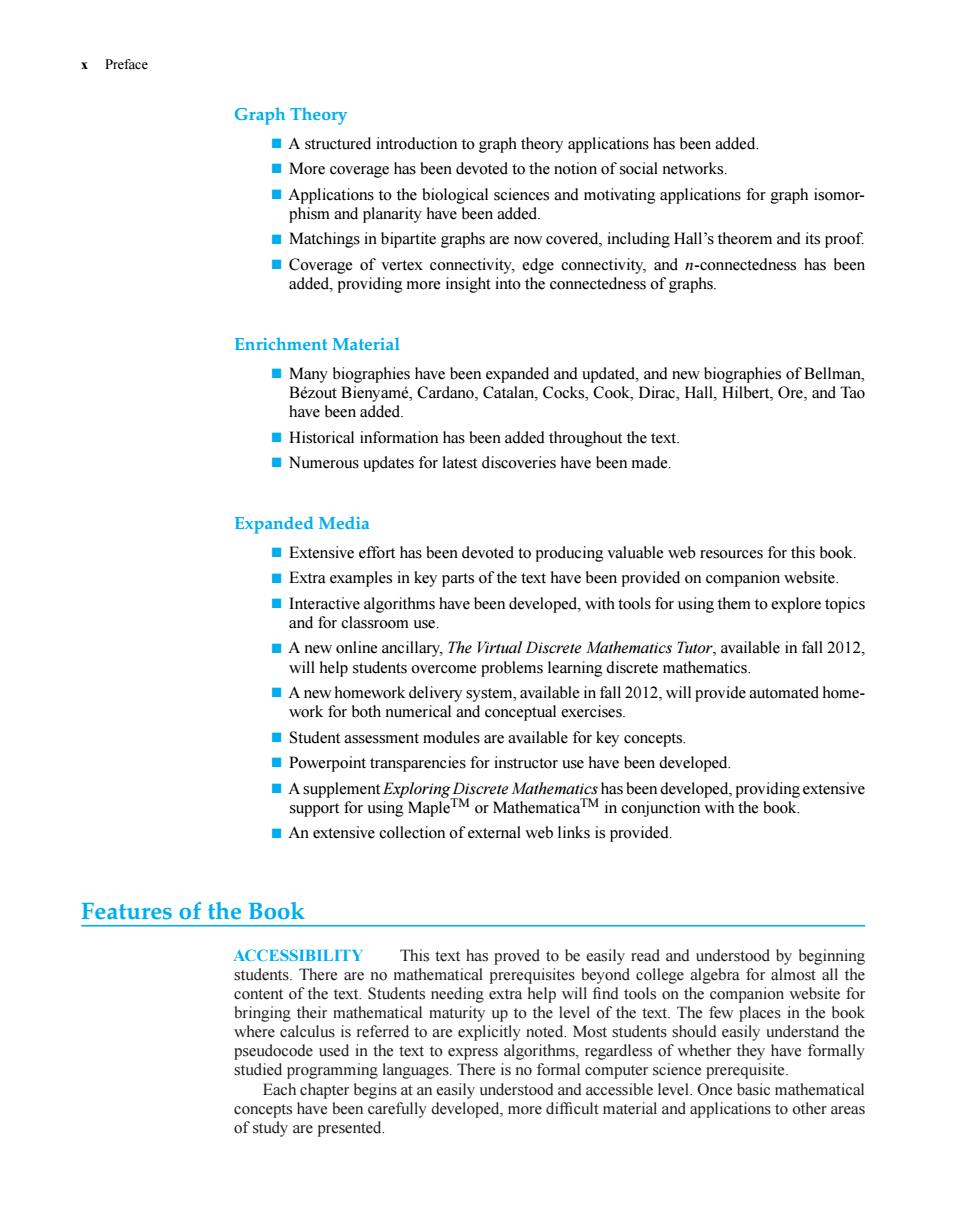正在加载图片...

x Preface Graph Theory A structured introduction to graph theory applications has been added. More coverage has been devoted to the notion of social networks. ”6paaposhmeexdsRandnonaaeplcaioasreapBomr Matchings in bipartite graphs are now covered,including Hall's theorem and its proof. onnectedness has been Enrichment Material many biographies have been expanded and updated and new biographies of bellmar Bezout Bienyame,Cardano,Catalan,Cocks,Cook,Dirac,Hall,Hilbert,Ore,and Tao have been added. Historical information has been added throughout the text Numerous updates for latest discoveries have been made. Expanded Media Extensive effort has been devoted to producing valuable web resources for this book Extra examples in key parts of the text have been provided on companion website. s have been developed,with tools for using them to explore topies A new online ancillary,The Virtual Discrete Mathematics Tutor,available in fall 2012, will help students overcome problems learning discrete mathematics. A new homework delivery system available in fall 2012 will provide automated home. work for both numerical and conceptual exercises ■Student asse ssment modules are available for key concepts Powerpoint transparencies for instructor use have been developed. An extensive collection of external web links is provided. Features of the Book ACCESSIBILITY This text has proved to be easily read and understood by beginning students mathematical prerequisites all th s ne where calculus is referred to are explicitly noted Most students should easily understand the pseudocode used in the text to express algorithms,regardless of whether they have formally studied programming languages.There is no formal computer science prerequisite. Each chapter begins at an easily understood and accessible level.Once basic mathematica x Preface Graph Theory A structured introduction to graph theory applications has been added. More coverage has been devoted to the notion of social networks. Applications to the biological sciences and motivating applications for graph isomorphism and planarity have been added. Matchings in bipartite graphs are now covered, including Hall’s theorem and its proof. Coverage of vertex connectivity, edge connectivity, and n-connectedness has been added, providing more insight into the connectedness of graphs. Enrichment Material Many biographies have been expanded and updated, and new biographies of Bellman, Bézout Bienyamé, Cardano, Catalan, Cocks, Cook, Dirac, Hall, Hilbert, Ore, and Tao have been added. Historical information has been added throughout the text. Numerous updates for latest discoveries have been made. Expanded Media Extensive effort has been devoted to producing valuable web resources for this book. Extra examples in key parts of the text have been provided on companion website. Interactive algorithms have been developed, with tools for using them to explore topics and for classroom use. A new online ancillary, The Virtual Discrete Mathematics Tutor, available in fall 2012, will help students overcome problems learning discrete mathematics. A new homework delivery system, available in fall 2012, will provide automated homework for both numerical and conceptual exercises. Student assessment modules are available for key concepts. Powerpoint transparencies for instructor use have been developed. A supplement Exploring Discrete Mathematics has been developed, providing extensive support for using MapleTM or MathematicaTM in conjunction with the book. An extensive collection of external web links is provided. Features of the Book ACCESSIBILITY This text has proved to be easily read and understood by beginning students. There are no mathematical prerequisites beyond college algebra for almost all the content of the text. Students needing extra help will find tools on the companion website for bringing their mathematical maturity up to the level of the text. The few places in the book where calculus is referred to are explicitly noted. Most students should easily understand the pseudocode used in the text to express algorithms, regardless of whether they have formally studied programming languages. There is no formal computer science prerequisite. Each chapter begins at an easily understood and accessible level. Once basic mathematical concepts have been carefully developed, more difficult material and applications to other areas of study are presented.�����������������